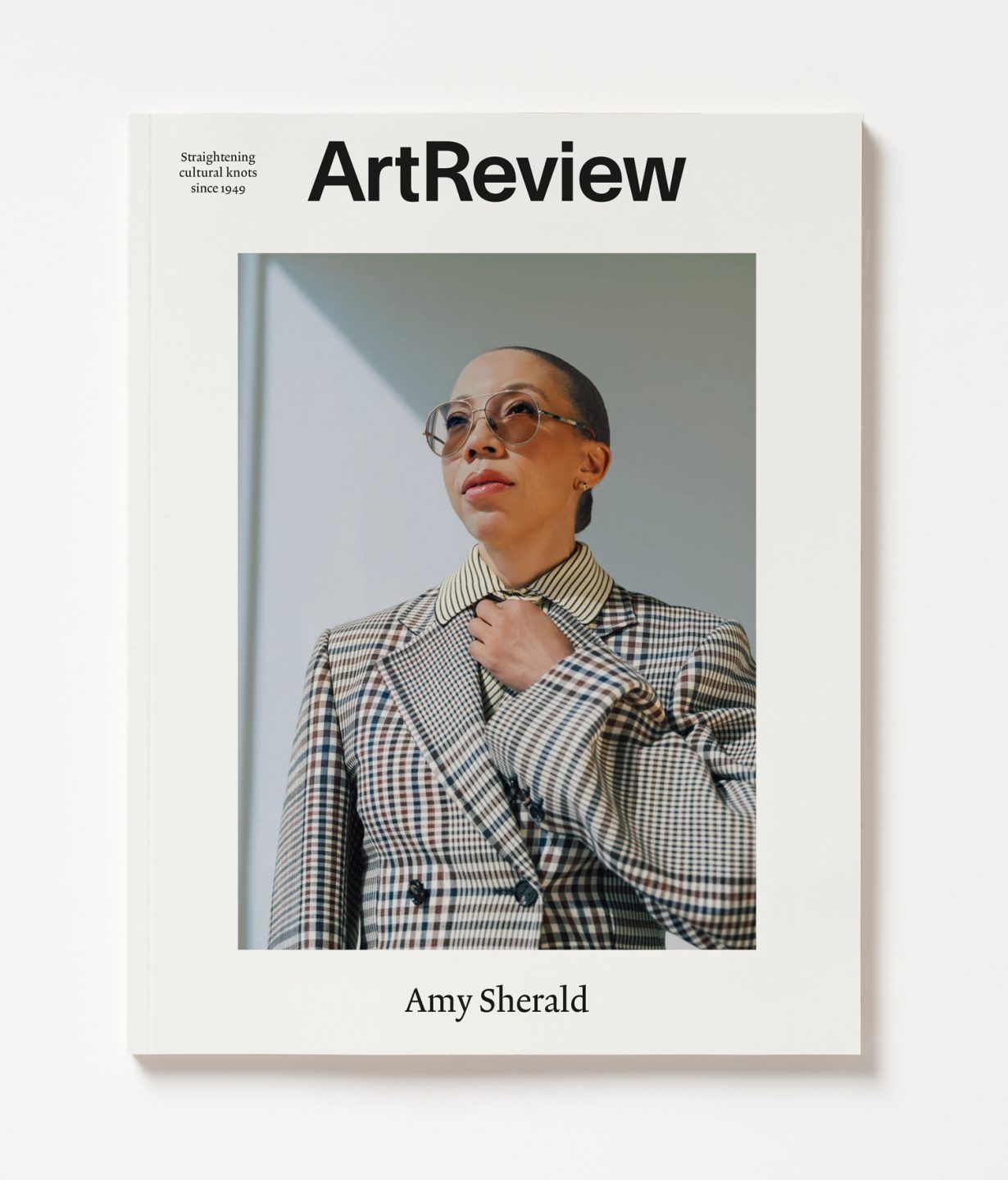
***Subscribe now or get your copy from our new online shop***
Grab your tools, we’re going digging. The May issue of ArtReview seeks out the in-betweens, the what-ifs and the all-at-onces: the spaces that can be carved out to make way for creative reimaginings.
Many of us may already be familiar with the compositional choices and flat yet vibrantly chromatic spaces of American portrait painter Amy Sherald – whose own portrait features on this month’s cover. But there’s room for surprise, as this issue takes an in-depth look at two works that stand out from the artist’s ongoing midcareer survey at the Whitney.
While most of Sherald’s works in the exhibition capture ‘fleeting moments in the daily life of everyday Black Americans’, writes Jenny Wu, the triptych Ecclesia (The Meeting of Inheritance and Horizons) (2024) ‘transports viewers out of the ordinary world of picket fences… into an ambiguous and surreal setting inhabited by unknowns’. Combining references to Christian iconography and Wes Anderson’s Grand Budapest Hotel (2014), the work’s atypical symbolism injects instability into the scene that hovers between spiritual and secular; naturalistic and stylised.
Hangman (2007), meanwhile, depicts a male figure, hovering midair. ‘Though the artist does not depict any instrument of torture, the pairing of a dangling body with titular allusion to a hanging tells us all we need to know,’ writes Allison Young. Without a noose, the body resembles a representation of Christ in ascension, prompting us to ‘reflect on questions of sacrifice and redemption, and to confront our own complicity in society’s many injustices… Sherald’s portrait is both a lamentation and a memento mori. We cannot resurrect our own departed, but we can answer the call to collectively world a more just future.’
Elsewhere, Martin Herbert considers conceptual artist Mario García Torres’s ‘urge to dilate the past and see it as changeable and expansible’. In his works, Torres rewrites art history through magical linkages between, say, Alighiero Boetti and himself or the Van Halen song Jump (1984) and the story of Muhammad Ali stopping someone from leaping off a building. In his revaluation and engagement with a hidden history of art, the artist, observes Herbert, shows that ‘nothing, seen through the widest lens, is really something, something spacious, endless’.
In Naomi Rincón Gallardo’s videoworks, storytelling is never linear, ‘because she is committed to the spiral temporality of Mesoamerican myth, in which past, present and diverse approaches to knowledge and history coexist in an always interlaced reality’, writes Gaby Cepeda. In films inhabited by surreal creatures clad in DIY costumes and navigating environments of sweat and soil, life becomes a series of dualities and contradictions that cannot be contained or rationalised.
Jessica Lanay observes what the Alaska-based Lingít and Unangax interdisciplinary artist Nicholas Galanin refers to as his life-work: whether withdrawing works from the Whitney in protest, joining apprentices in the sculpting of a dugout healing canoe or placing a 110-metre-long ‘Hollywood’-style sign reading ‘Indian Land’ in the Coachella Valley, Galanin seeks to preserve and extend knowledge, and make a material difference. His main demand, consistent in life and work, is that everything that has been taken from Indigenous people be returned.
Also in this issue, Emily May interviews Marseille-based Irish choreographer Oona Doherty about her recent works, delving into the apparent renaissance in Irish art and culture both at home and abroad, and her navigation of the spaces of theatre and visual arts. Fi Churchman annotates George Eliot’s essay ‘The Natural History of German Life’, which warns against the moral dangers of a disconnected and unrealistic view of the working class. Meanwhile, Sarah Jilani argues that baggy terms such as ‘Global South’ and ‘Global Majority’ are useless, because you can’t address what you can’t describe; Oliver Basciano finds that literary events are a hotbed of networking and flirting; Kat Kitay thinks it’s time for digital artists to up their game; and J.J. Charlesworth wonders who wants state funding, with its attached strings and bureaucratic policies?
Plus, reviews of exhibitions around the globe, from Desert X 2025 in the Coachella Valley, to Paris Noir in Paris, Islamic Arts Biennale in Jeddah, Ed Atkins in London and Emma Talbot in Copenhagen, and of books by Ocean Vuong, Hito Steyerl, Charlie Porter, Giorgio de Chirico.
That’s not all. ArtReview’s May issue is accompanied by a 66-page standalone publication on philanthropy in the arts, with essays exploring funding models in North and South America, Africa, Europe and Asia, profiles of four prominent philanthropists and a guide to philanthropic initiatives around the world.
***Subscribe now or get your copy from our new online shop***